
John Fithian, president and CEO of the National Association of Theatre Owners, discusses movie releases from 2017 at CinemaCon 2018, the official convention of the National Association of Theatre Owners, at Caesars Palace on April 24, 2018, in Las Vegas.Chris Pizzello/The Associated Press
The metaphors came fast and easy at this year’s CinemaCon.
The annual convention of the National Association of Theatre Owners (NATO; and yes, they’ve heard all the Warsaw Pact jokes) is a four-day frenzy of back-patting between Hollywood and the operators of the world’s movie screens. Each party is there, deep inside the bowels of Caesars Palace in Las Vegas, to convince the other that theirs is a business of tremendous innovation – one primed to learn from past mistakes, immune to the waves of disruption rocking the entertainment landscape and, most importantly, able to deliver what audiences want, how they want it.
All of which made the moment when CinemaCon kicked off with a nod to Jordan Peele’s Us all too perfect in its imperfection. As Mitch Neuhauser, CinemaCon’s managing director, gleefully walked on-stage dressed as one of Peele’s red-jumpsuited villains, I couldn’t help but grimace as exhibitors and executives cheered on a movie that is (spoiler alert) about one part of humanity failing to come to grips with the fact that their time on this Earth is over.

From left: Black Widow/Natasha Romanoff (Scarlett Johansson) and Captain America/Steve Rogers (Chris Evans) in Avengers: Endgame.null/Marvel Studios
It was a moment of allegorical obliviousness that was echoed the following morning, when NATO chief John Fithian delivered a blood-alone-moves-the-wheels-of-history-esque speech – “a robust theatrical release provides a level of prestige to a movie that CANNOT be replicated!” – within direct eyesight of an obvious, continuing crisis (paramedics were treating a woman who fell off the stage not five feet away; she’s okay). To cap it off, CinemaCon closed with its audience whooping for Terminator: Dark Fate, a film that erases the continuity of the three previous Terminator sequels, thus acting as a convenient lesson on how to stick a thumb in the eye of those whom Hollywood proclaims to care most about: moviegoers.
Sure, the film world has good reason to be cocky. The North American box office hit a record high of US$11.9-billion in 2018, up 7 per cent from the year before. And this year’s stupidly intimidating blockbuster lineup – including Avengers: Endgame, Toy Story 4, Frozen 2 and Star Wars: Episode 9 – could gross just as much … for Walt Disney Pictures alone.
Yet streaming is on a dramatic global rise, with the Motion Picture Association of America reporting last month that 613 million people subscribed to online video services in 2018, a jump of 27 per cent from the year before. And for every familiar brand extension that hits (how many Spider-Men can audiences take? All of them, it turns out), Hollywood still churns out lazy would-be franchises (Robin Hood, Mortal Engines, Solo, Pacific Rim: Uprising) whose desperate stench only alienates audiences further.
If CinemaCon 2019 confirmed anything, it was not that the magic of the theatrical experience – however ineffable and true – can save movies. It was only that, by refusing to budge from a franchise-heavy and innovation-averse strategy, the film industry is slouching toward its very own Judgment Day. Come with me, then, if you want to live.

This year’s stupidly intimidating blockbuster lineup – including Avengers: Endgame, Toy Story 4, Frozen 2 and Star Wars: Episode 9 – could gross plenty for Walt Disney Pictures.null/Marvel Studios
WHISPER TO A STREAM
The first inkling that this year’s CinemaCon would be less a hermetic industry bubble and more a full-on BioDome was the absence of one word: “Netflix.” Even though the streaming giant arguably commands more global attention than all the major Hollywood studios combined – 139 million subscribers worldwide, with plans to release 90 original films this year – and has now secured Oscars prestige thanks to Alfonso Cuaron’s Roma, almost no one in Vegas referenced the streamer by name.
This is thanks to a long-standing stalemate between Netflix and exhibitors over how long it should take for a film to make its way from the big to small screen. Netflix wants to make its movies available to subscribers a week or two after they play theatres, or on the very same day. Exhibitors believe that such a short window cannibalizes their business (the average time between traditional theatrical and digital platforms is 97 days, according to NATO). This has led to Netflix simply renting out theatre space where it can to gain exposure for award contenders such as Roma. And reports indicate the company will do the same for this year’s epic and costly drama The Irishman, director Martin Scorsese’s first Netflix film and the company’s biggest bet yet for Best Picture, and thus cultural dominance.
Yet instead of addressing this problem head on, CinemaCon played a game of see-no-evil, a charade that felt like the plot to Netflix’s own thriller Bird Box: Strap on a blindfold, hope for the best and pray you don’t accidentally glimpse the horrors that surround you.
“Cinema: It’s a word we hear a lot lately,” Tom Quinn, co-founder of upstart U.S. distributor Neon, said during CinemaCon’s opening-night ceremony. “Some in our business have tried to co-opt it for their own gain. Those who have are not here this week.”
True, Netflix had no public presence at CinemaCon. But privately, distributors, executives and analysts filled Caesars’ steakhouses and cigar bars with grousing about the sheer amount of money being left on the table thanks to the intransigence of both the streamer and NATO members.

The Lion King (2019).Disney
If the two factions could reach a middle-ground – say, a 30- or 40-day theatrical window instead of 90 – then everyone would benefit. Cinemas would get the original, diverse and zeitgeisty content that audiences are gobbling up at home. Netflix would get the prestige of theatrical exhibition, as well as the unique experiential alchemy – that “electric feeling of seeing a movie on the big screen for the very first time,” as Universal Pictures chief Donna Langley put it – which goes along with it.
Not that anyone would admit such a thing in the open. Not when theatre chains are warily eyeing 2019′s box-office receipts, which are currently off by about 20 per cent compared with last year. And not when they’re wondering what Netflix has planned – plus whatever dangers loom from a half-dozen other streamers, including giants such as Apple TV+ and Disney+. The latter’s expansion into streaming especially stings, given that Disney positions itself as the best friend a multiplex can have.
“This is one of the multibillion-dollar questions right now,” said Paul Dergarabedian, senior media analyst for comScore. “Today, what Disney is doing is creating content in theatres that can be used for its streaming service down the road. But where is it all going to fit eventually?”

President of Walt Disney Distribution Franchise Management, Business & Audience Insights, Cathleen Taff, speaks in front of the studios part of Walt Disney Studio on screen during the CinemaCon Walt Disney Studios Motion Pictures special presentation at the Colosseum Caesars Palace.VALERIE MACON/AFP/Getty Images
While Disney’s streaming service has yet to materialize, Netflix is a harsh reality. The streamer is far from perfect – its viewership data is sketchy, its devotion to pure growth unsustainable, its tendency to bury interesting titles deplorable – but it is picking up a game Hollywood has shown little interest lately in playing. Which is why the few times that the company’s name did come up in Vegas, it was with explicit bitterness.
“The first 17 questions are about Netflix. This is a really big industry with all kinds of amazing content creators who get distributed in lots of different ways and consumed in lots of different ways,” Fithian told reporters during a tense interview session. “It’s surprising to me that most of the prestories on CinemaCon and all of your questions … are about Netflix.”
Yet NATO has clearly been thinking about, if not answering, the Netflix question. Ahead of CinemaCon, the organization released a study it commissioned from Ernst & Young, which found that Americans who went out to see movies more frequently also tended to consume more streaming content. “For every race and age demographic, average streaming hours per week was higher for respondents who visited a movie theater nine times per year or more compared to those who visited a theater only once or twice,” Fithian said. “Streaming and theatrical don’t just co‐exist, they reinforce each other.”

Producer Jonas Rivera of Pixar Animation Studios discusses the upcoming film Toy Story 4 during the Walt Disney Studios Motion Pictures presentation at CinemaCon 2019.Chris Pizzello/The Associated Press
Or it could be that those people who like movies tend to, well, see a lot of movies. And if theatre owners and Netflix could end their detente, the much-rhapsodized “magic” of the communal movie-going experience could become stronger than ever, for both creators and consumers.
But then actor Helen Mirren came out at CinemaCon to promote her thriller The Good Liar, announced to the audience that “I love Netflix, but [expletive] Netflix,” the crowd of exhibitors went wild and the conversation fell back to the same us-versus-them mentality that serves no one. Least of all audiences.
‘I’LL BE BACK, AGAIN’
For all that Hollywood professes to serve at the pleasure of the movie-going public – “Audiences will show up for great original movies from brilliant filmmakers,” Universal’s Langley said – CinemaCon’s general message to audiences seemed to be: Sit down and shut up. While Netflix is producing and acquiring original and diverse mid-budget dramas in a bid to draw in subscribers hungry for anything non-franchise – in the past half year it has released new films from Dan Gilroy, Chiwetel Ejiofor, Tamara Jenkins, Joel and Ethan Coen, Nicole Holofcener, Steven Soderbergh and some guy named Orson Welles – Hollywood studios are doubling down on familiarity.

Linda Hamilton in Terminator: Dark Fate.Paramount Pictures.
In addition to a new Terminator (the sixth), prepare for a new Top Gun, a new G.I. Joe, a new Quiet Place and Coming 2 America. And that’s just what’s on tap from Paramount Pictures. With its recent US$71.3-billion acquisition of 21st Century Fox assets, Disney is also an intellectual-property behemoth, and the newly enhanced superconglomerate used CinemaCon as a victory lap to announce plans for more from the Planet of the Apes, Kingsman, Avatar and Alien franchises (not all in the same movie … at least not yet). This doesn’t include Disney’s Marvel and Star Wars brands, nor its increasingly frequent trips to the Disney vault, where any classic cartoon can be reverse-engineered into a “live-action” remake, à la this year’s triple threat of Dumbo, The Lion King and Aladdin (the last of which looks like pure nightmare fuel).
Even the smaller, so-called original films feel familiar. STX Entertainment chairman Adam Fogelson touted his studio’s reputation of “[disrupting] the traditional industry standard” and a 2019 lineup that will “fill noticeable gaps in the marketplace.” But productions like My Spy (a mashup of The Pacifier and Kindergarten Cop), The Gentlemen (another tough-guys-and-stylish-ties joint from Guy Ritchie) and Bad Moms’ Moms (that’d be a sequel to A Bad Moms Christmas) felt as fresh as the air inside the CinemaCon press room. Lionsgate, meanwhile, had the curious idea of rebranding itself as “A Home for Artists to Thrive” -- which I guess includes the Hellboy reboot and the third John Wick movie. (Before you yell at me: the John Wick franchise is fantastically fun, but, c’mon.)
Between previews of creaky tentpoles and the promise of yet more intellectual-property exploitation for decades to come – there were audible gasps inside Caesars’ Colosseum when Disney displayed its upcoming release calendar, so littered was it with name-brand properties – there were quick, hopeful nods to original films for diverse audiences.

Mackenzie Davis in Terminator: Dark Fate.Paramount Pictures.
Two of the four movies screened in their entirety for the CinemaCon audience – Gurinder Chadha’s coming-of-age drama Blinded By the Light, and Nisha Ganatra’s comedy Late Night, both instant crowd-pleasers – star Indian performers and come from filmmakers of Indian descent. Universal Pictures, too, put up a good front with presentations for the diversity-forward comedies Little, starring Black-ish’s Marsai Martin, and Yesterday, starring newcomer Himesh Patel, plus Lena Waithe and Melina Matsoukas’s Black Lives Matter-adjacent drama Queen & Slim.
“We’re a melting pot, and that melting pot has a tremendous interest in learning about diversity and inclusion,” said Rolando Rodriguez, chief executive of the American chain Marcus Theatres. “The reason you do diversity and inclusion is not just that it’s the right thing to do, but it’s the right thing for business.”
Yet, in another instance of Hollywood leaving money on the table by clinging to the past, diversity still seems more like a fuzzy promise or a programming outlier than a sincere commitment. Warner touted the success of Jon M. Chu’s 2018 rom-com Crazy Rich Asians, but it felt more comfortable pushing familiar franchise offerings such as Godzilla: King of the Monsters and Todd Phillips’s Joker than its diversity-forward offerings such as the YA immigration romance The Sun Is Also a Star. The same marketing wariness could be felt at Paramount, Lionsgate and Disney, with the latter concentrating almost exclusively on white-bread familiarity (the exception: the Kumail Nanjiani-starring comedy Stuber, which Disney didn’t develop but acquired when it absorbed Fox).
The success of Crazy Rich Asians, Get Out, Hidden Figures and Us has proven that the market is eagerly anticipating a flood of diverse productions. Yet, CinemaCon offered only a trickle.
“There are 60 million Latinos, for instance, in the United States," said Moctesuma Esparza, whose production and distribution company Maya Entertainment is aimed at America’s Latino market. "If you give audiences something they can relate to where they see themselves, well, we’re all going to make a lot more money.”

Dwayne Johnson and Jason Statham in Fast & Furious Presents: Hobbs & Shaw.Universal Pictures
RISE OF THE MACHINES
In the meantime, if exhibitors can’t count on the content immediately improving, they will do their damndest to enhance every single other facet of the movie-going experience. No matter how unnecessary.
A few floors from where Dwayne Johnson, Halle Berry and Arnold Schwarzenegger made quippy appearances to promote their sequels, another level of CinemaCon was devoted to showcasing the latest in screen, sound, seat, aisle, carpet and hot-dog technology. Do you want ScreenX auditoriums, which offer 270-degree panoramic action? How about MX4D, where you’ll experience everything from water blasts and neck ticklers to "seat poppers”? There are also innumerable ways in which concession stands can serve processed meat, including something called Roller Bites (“Behold Deliciousness”) and too many variations on churros and pretzels (yet not, disappointingly, a churetzel, which I’m now copyrighting).
The upgrades were so overwhelming they tipped over from innovation into silliness. You can’t get this at home … but would you want to get it anywhere, at all? The industry’s last big trick, 3-D, has shown diminishing returns, with the MPAA recently reporting that the global market for 3-D dropped by 20 per cent in 2018. The next trend, then: Premium large format systems, with Sony getting into a game that’s so far been ruled by Imax and Dolby. Go big, but don’t dare go home. Unsurprisingly, it was difficult to find any cynicism on CinemaCon’s trade-show floor.
"We're in an industry that's always evolving, driven by consumer behaviour that asks us to keep making sure we can deliver a great movie-going experience," said Carl Rijsbrack, chief marketing officer for theatre-tech giant Cinionic. "Whether it's brighter resolution or bigger screens or better sound, we're on a constant evolutionary track to make sure we go one step beyond."

Idris Elba joins Dwayne Johnson and Jason Statham in Fast & Furious Presents: Hobbs & Shaw.Universal Pictures
But with that sort of evolution comes a higher price tag – which risks driving away audiences already frustrated with the modern stakes of movie-going. An adult ticket for a screening in one of Cineplex’s new Canadian locations of ScreenX, for instance, runs $18.99. And a ticket for Cineplex’s “hyper-realistic, immersive entertainment experience” called D-BOX? That goes for $24.50.
Last year, on the final night of CinemaCon 2018, I did a very stupid thing and went to see an 11 p.m. screening of Avengers: Infinity War at a Vegas multiplex. The seats were comfy, the picture sharp, the sound crystal-clear. But watching the movie was a chore. It felt like an aggressive sales pitch on behalf of Disney, and as if I was performing labour by just sitting there. I left the theatre bleary-eyed and feeling used, not appreciated – and certainly not under any “magical” spell of the communal theatrical experience.
This year in Vegas, I could have gone out to see Shazam, the latest superhero movie, or Pet Semetary, the latest horror reboot. Instead, I spent my final night at CinemaCon 2019 laying on my hotel bed, having connected my laptop to my room’s sizable television screen. My seat was comfy, the picture fine, the sound clear enough. And then I watched Netflix.
Live your best. We have a daily Life & Arts newsletter, providing you with our latest stories on health, travel, food and culture. Sign up today.
 Barry Hertz
Barry Hertz